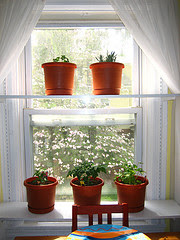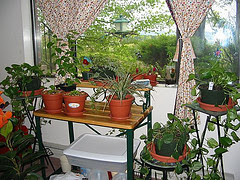Not all insects are pests. In fact, the majority of bugs living in your garden are helping your plants to grow in numerous, unseen ways. If you are having a problem with pests in your garden, you probably have an imbalance of fauna or an imbalance of soil nutrients. The more insects and other fauna in your garden, the less likelihood the “pesky” ones have of surviving. You will find that most insects eat those moths and maggots that are eating your plants.
How biodiversity keeps your garden growing
Biodiversity is the key to a healthy organic garden. Biodiversity means the presence of a diverse collection of plants and animals. Commercial mono-crops require obscene amounts of chemicals because they have an un-healthy level of diversity.
In un-touched nature, pests and plant diseases do exist, but rarely get out of hand. This is because there is a natural system of checks and balances, which keep these things under control. Of course, your garden is not “untouched nature”- it is quite touched. You have planted plants here, which are not naturally occurring, you weed and dig and manipulate the earth and you will likewise have to encourage a balance in natural diversity.
How to control your aphids
If you have a problem with aphids in your vegetable or flower garden, you may want to introduce an insect, which feeds on Aphids. The most common of these is the Ladybug. The Ladybug and her larvae feed on Aphids, mites and small caterpillars. The larvae are especially active between May and July. Ladybugs are available at your local nursery as well as through mail order. Gardens Alive, an environmentally responsible gardening company is the preferred place to purchase them.
Encourage beneficial insects to visit your garden
If you are having a problem with fruit tree spider mites, green flies or small caterpillars, you can encourage Hover flies in your garden. Hover flies resemble dark bees or wasps. They tend to hover over plants and dart around quickly. Bring Hoverflies into your garden by planting marigolds, phacelia or “poached egg” plants throughout.
Dragonflies are good for your garden too. Dragonflies eat mosquitoes. If there has been spraying in your area for mosquitoes, chances are the spray has killed the dragonflies too. If you are afraid that your dragonfly population has been taken out, re-introduce them either by purchasing through mail-order, or by planting reedy plants in or around your garden.
A frog is a prince in the organic garden
Building a pond near your garden will encourage amphibians. Amphibians, especially frogs, are great friends of your garden as they eat many flies, moths and flying insects. A pond will also encourage dragonflies, which eat mosquitoes.
Plant and encourage the growth of as many different types of aquatic plants in your pond as you can. With an increased density of aquatic plants an increased diversity of pond associated insects (including dragonflies) will inhabit your pond and feed on an wider range of insect pests.
Why most insects should be protected
An organic farmer should not and cannot eliminate every insect in his garden. Most insects are so tiny and mobile that most people never even realize that they exist. Spraying pesticides indiscriminately is the worst thing you can do for your garden. Take some time one afternoon to sit quietly in your garden and watch your plants, you will be amazed at the amount of life that exists there! Appreciating all of the life in your garden is part of being an organic farmer and a friend of the earth.
Bees are great insects for your garden. Fruit trees that require pollination cannot live without bees! Encouraging bees in your garden is easy; they love flowers. Plant lavender, rosemary, daisies, cosmos, heather and/or marigolds around the outside and amongst the other plants of your garden and the bees will come.
Organic gardens are for the birds... seriously!
Birds are another great form of natural pest control. Birds and bats live off of bugs. It is unfortunate and ironic that pesticides often end up killing or harming local birds. Plant your garden near tall trees. Birds will establish nests in the trees and visit your garden to eat pesky beetles, moths and flies.
Imitate Mother Nature through Diversity
The very best way to encourage a diverse collection of life in your garden is by planting a variety of plants. While some of the pests will be attracted to some of your plants, the other plants will attract the friendly insects. The more plant diversity in your garden, the more insect diversity. Talk to your local nursery about native plants in your area and stick with those.
The importance of buying local
Be aware when buying potted plants that they have been grown locally and carefully. Imported plants may contain imported insects. If your pests are local, chances are they have local enemies. If your pests are imported, they may not have any local predators in your garden.
Organic gardening is about maintaining balance
Be aware when introducing insects into your garden intentionally, even beneficial ones. Do not introduce insects if their prey does not exist in your garden. If you introduce a population of insects but not feeding them, then you are harming the diversity of your garden rather than encouraging it by throwing off the balance.
When you look at your garden is it a mess of beautiful color? Are birds, bees and flies hovering overhead? Does your garden fit naturally into the landscape with a variety of native plants and animals? With a healthy diversity of insects and other fauna, your garden will be healthy, have very little insect herbivory and local populations of animals will maintain healthy populations.
Beneficial Insects Will Control the Bad Insects
Some insects like the Ladybug and the Green Lacewing are called beneficial because they are the good guys who are on the hunt for the bad guys that are feeding on your plants. Here is a list of beneficial insects, with links to where they are offered by an Earth friendly distributor.


Green Lacewings Chrysoperla carnea 
Green Lacewings are an all purpose beneficial insect that feed on insects such as aphids and other insects that will come and feed on your plants. Green Lacewings are perfect for a backyard garden, larger garden, or a greenhouse.
LadyBugs 
The most popular beneficial insect, these cute little beetles eat Aphids and Spider-mites and can be purchased readily in most nurseries. Don’t discount their black, alligator like larvae which eat up to a hundred aphids a day!
Minute Pirate Bug
These little guys eat Thrips, Corn Earworms, Aphids and Spider-mites. Though be careful not to pick these guys up as they have a nasty bite.
Predatory Mites
These mites feed on Thrips and Pest mites.
Praying Mantis
These big guys also eat a lot of beneficial insects, so they are not recommended for your garden.
Rove Beetles
These beetles feed on soil-dwelling insects like Root maggot eggs, larvae and pupae, especially those of Cabbage maggots and Onion Maggots. They also eat slug and snail eggs.
Soldier Beetles
These beetles eat Aphids, Caterpillars, Corn Rootworms, Cucumber Beetles and Grasshopper eggs.
Spiders
All spiders are beneficial predators. You should encourage them into your garden by using a straw mulch.
Spined Soldier Bugs
These bugs eat the Larvae of Colorado Potato Beetles, Sawflies, Cabbage Loopers and Tent Caterpillars.
Tachinid Flies
These flies eat Caterpillars, Armyworms, Cornborers, Cutworms and Stinkbugs.
Tiger Beetles
These beetles eat various soil-dwelling larvae.
Trichogramma Wasps
These weird and tiny wasps lay their eggs inside the eggs of moths, killing the mother moth in the process.
Yellow Jackets
These bees feed the larvae of flies, Caterpillars and Grasshoppers to their young.
Most of these beneficial insects can be purchased in a nursery or through mail order. Those that cannot be purchased may be naturally attracted to your garden if you plant specific plants.
Do not release these beneficial insects into your garden if their prey does not exist there. If you do so, you may disrupt your garden’s natural ecosystem and possibly worsen your pest problems.
Growing a diversity of plants in your garden will attract a range of insects, and most insects are beneficial. Beneficial insects are only one of many reasons to maintain a diverse collection of plants in your garden.
Beneficial creatures are not all insects. Birds and bats feed on insects as well and may be helpful to have in the neighbourhood. Pesticides, ironically, can kill birds, which may themselves be your best ‘pesticide’.
Reptiles and amphibians are also beneficial creatures. Building a pond on your land will encourage frogs and toads to reproduce, and these amphibians will then eat flies and other insects.
Source : http://www.helpfulgardener.com/organic/2006/beneficial.html
























